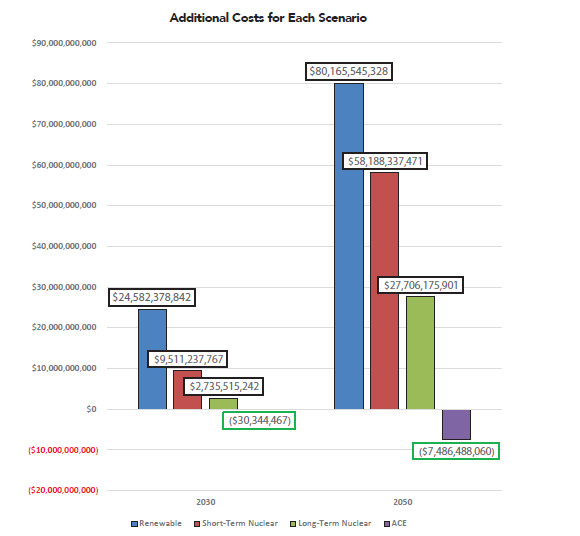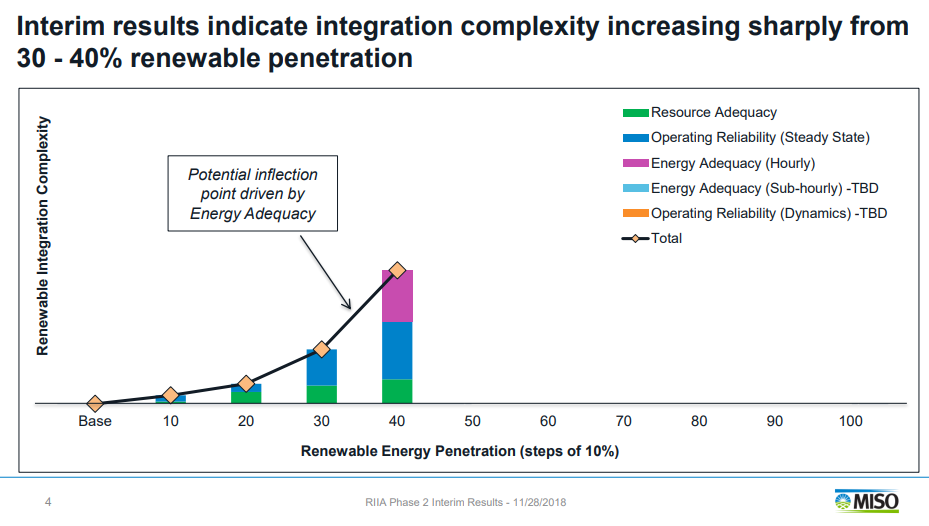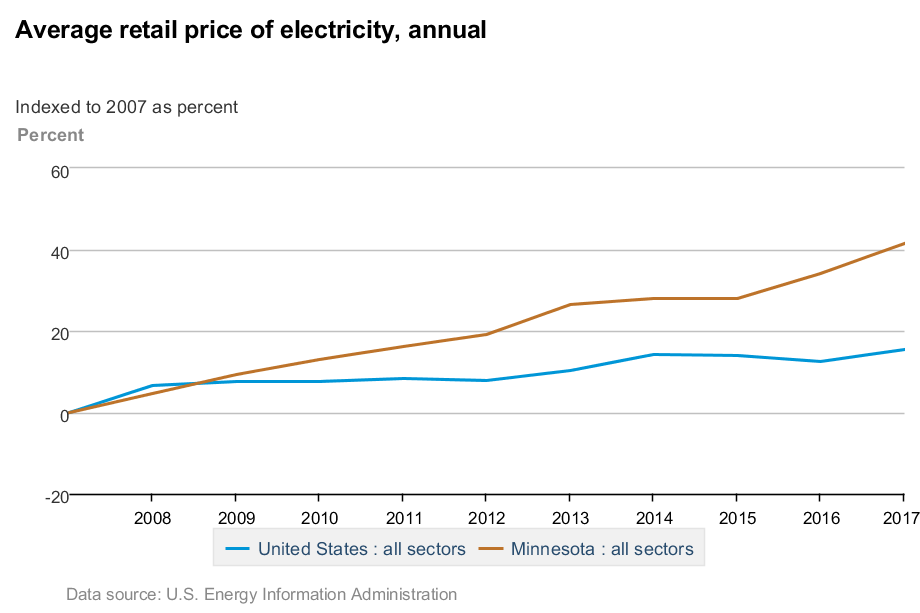Minnesota Citizen’s Utility Board Harms Ratepayers By Advocating For Bad Policy
The executive director of the Minnesota Citizen’s Utility Board recently wrote an opinion editorial to the Duluth News Tribune that was supposed to be a rebuttal of the article I wrote explaining how a 50 percent renewable energy mandate would drive up the cost of electricity for mining and paper mills, costing them an additional $200 million each year.
However, the piece makes several common but inaccurate arguments about the impacts of adding more wind and solar to Minnesota’s electric grid. I address each of these arguments below.
From the article:
A “Statewide View” column headlined, “Minnesotans ought to be concerned by state’s sweeping energy transformation,” was published March 26; and a “Statewide View” headlined, “Skyrocketing electricity prices threaten Minnesota mining,” was published March 20. Both commentaries mischaracterized the reality of clean energy in our state in an apparent attempt to scare us away from supporting new, clean-energy goals currently under consideration in the Minnesota Legislature.
Speaking as the leading advocate for energy consumers in Minnesota, I can say that clean energy is the best option if we want to keep our energy bills low.
If wind and solar were truly the best option for keeping bills low, then consumers would have seen their bills decrease in inflation-adjusted dollars since 2007, when we began mandating renewable energy on the grid, because utility company profits would decrease as coal plants depreciated, thereby reducing the amount of money they are guarnateed to make every year. This guaranteed amount is called their “revenue requirement” in industry lingo.
Instead, Minnesota households saw their bills increase 8 percent in inflation-adjusted dollars even though they used 10 percent less electricity in 2017 than they did in 2007. In short, they paid more of their money for less electricity as we added more wind and solar to the grid.

This portion of the article earns a “pants on fire” rating. The article continues:
Anyone claiming that transitioning to clean energy will raise utility bills for Minnesotans has not been reading the news. Simply put, renewable energy is the lowest-cost energy resource in Minnesota today. Wind energy, even without subsidies, is now cheaper than coal and natural gas. The cost of wind and solar energy fell 16 percent and 23 percent respectively last year, and costs are still decreasing. Clean energy is so cheap that utilities can build new wind turbines for less than it costs to simply operate existing coal power plants.
Claims that wind and solar are cheaper than coal are demonstrably false. As I wrote at the Star Tribune:
Form 1 data submitted to the Federal Energy Regulatory Commission (FERC) by Minnesota utilities show the cost of generating electricity at two of Minnesota’s largest coal plants, Sherburne County and Clay Boswell, was $30.58 per megawatt hour (MWh) and $32.34 per MWh, respectively, in 2017, the most recent year for which data were available.
In contrast, Bloomberg New Energy Finance estimates the unsubsidized cost of generating electricity from new wind is $38 per megawatt hour, meaning it is 24 percent more expensive than electricity from Sherburne County.
Furthermore, the numbers CUB used to bolster its case for falling costs for renewable energy are from Bloomberg New Energy Finance (BNEF). These numbers show the cost of wind to be $38 per MWh, without subsidies, and solar unsubsidized solar to be approximately $60 per MWh, twice the cost of existing coal. However, I am deeply skeptical about both their wind and solar estimates because they refused to share the assumptions they used to calculate their LCOE values, even though they originally said they would.
The screenshot below is an email I received from a representative from BNEF after two weeks of asking for their assumptions.

In contrast, our report, which is very transparent, found the unsubsidized cost of wind was $48.69 per MWh and solar was $117.10 per MWh, and this does not include the massive costs associated with transmission, load balancing (providing electricity when the sun isn’t shining or the wind isn’t blowing, which is most of the time), utility profits, or increased property taxes. When all of these costs were taken into account, the true cost of wind was $113 per MWh.

This claim by CUB also receives a “pants on fire” rating. Continuing:
That means that if we continue to rely on traditional power generation, we’ll pay too much. A study released by the McKnight Foundation last year estimated that transitioning to clean energy will save the average household between $600 and $1,200 each year. The savings for a larger user of electricity, like a mine or a mill, would be much, much greater.
Plus, building new fossil-fuel power plants today means taking on a big risk. Power plants are long-term investments to the tune of billions of dollars. They get paid off gradually over the decades they’re in operation, which is traditionally a predictable expense that makes up a big part of our electric rates. A typical gas power plant might be paid off as it’s producing power over 30 years. However, with renewables already the cheapest source of energy and getting cheaper, it’s pretty likely that a gas plant built today won’t be cost-effective to run in 30 years. If a power plant gets priced out of operating before it has been paid off, consumers could end up on the hook for paying down the remaining debt, potentially hundreds of millions of dollars or more.
It’s interesting that our report, Doubling Down on Failure found just the opposite. The average Minnesota household will pay $,1200 per year, every year, through 2050 due to spending $80.2 billion on wind turbines, solar panels, and the natural gas facilities needed to provide electricity when the weather doesn’t cooperate. Furthermore, the Manhattan Contrarian, a respected blogger and self-described “math geek” wrote an article stating our numbers were far too conservative. I’ll look into this McKight Foundation study further, but I’m guessing it won’t stand up to scrutiny.
Furthermore, who’s building new fossil fuel plants when we already have more than enough generation capacity to meet our demand? Xcel Energy wants to build more gas plants because the monopoly utility wants to make money off of them, but Minnesota should keep using it’s existing coal plants for as long as possible. Our study found doing so would save Minnesota $7.5 billion, relative to 2016 prices.

This passage gets a rating of “mostly clueless.” Continuing:
There’s no doubt the electric system can accommodate much higher levels of renewables than are on the system today. Engineering studies have shown this, and it is being demonstrated by power systems around the world. Utilities and the organizations that manage electric grids are continually getting better at integrating renewable energy.
Minnesota Gov. Tim Walz has proposed 100 percent clean electricity by 2050, and legislation is currently moving through the Minnesota House to require utilities to meet that goal — but not at any cost. If it turns out that getting to 100 percent would make electricity expensive or unreliable, utilities wouldn’t have to do it. This same off-ramp was included in the 2007 renewable-energy standard. It turned out that the off-ramp wasn’t necessary, however; utilities reached the required 25 percent renewable-energy goal years early without problems.
I hope it will be unnecessary again as we move toward 100 percent, but it’s an important option to have until we know for sure.
The Citizens Utility Board of Minnesota hears from people every week: Consumers want affordable clean energy. Fortunately, clean energy is the path that will keep costs low for all of us.
Two things here. 1) The Midcontinent Independent Systems Operator (MISO) has shown it will be exponentially more difficult to increase our reliance upon renewables from 20 percent today, to 40 percent in the future, and 2) the 25 percent renewable energy mandate caused Minnesota’s electricity prices to increase 26 percent faster than the national average since 2007.


It is clear that the Citizens Utility Board is unwilling to advocate for the policies that will actually reduce costs for consumers. As such, that makes Center of the American Experiment the leading advocate for energy consumers in Minnesota, and we can say that utilizing Minnesota’s existing coal-fired power plants for the foreseeable future is the single-best way to keep our energy bills low, not adding unreliable and expensive sources like wind and solar to the energy mix.